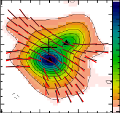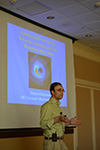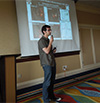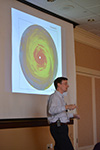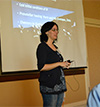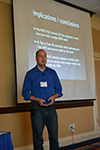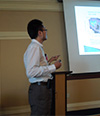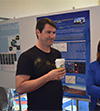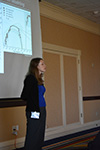Complete presentation: Oral session I-invited
Sean Andrews (CfA)
Protoplanetary Disk Structures with the SMA
I will highlight some of the key results related to measurements of protoplanetary disk structures made with the SMA over the past decade. Specific topics will include the basic demographic impacts of evolution and environment, constraints on densities and other basic physical conditions, and indirect evidence for giant planet formation (the so‑called transition disks). I will conclude with an effort to showcase how these SMA-based studies are in large part responsible for driving the (current and) future directions of research on disks and planet formation.
View: Poster and Poster Blast
Mohaddesseh Azimlu (CfA),
Qizhou
Zhang, Michel Fich, Carolyn McCoey
Extremely High-Velocity Outflow in Small Star-Forming Association
We have detected one of the most extended and highest-velocity outflows ever observed with SMA in a small star-forming association at a distance of 1.1 kpc. The outflow is ~ 200 km/s in extent and has a clumpy structure containing extremely-high-velocity ejecta. The red lobes and blue lobes are not collimated and probably are created by more than one outflow. Another possibility is a bipolar outflow, but the only resolved compact source in the 1.3 mm continuum map in both compact and extended configurations is shifted from the center of a possible bipolar cavity. This compact source has a total flux density of 1.3 Jy, which indicates a ~ 20 M⊙ core. The core probably contains multiple protostars, but they have not been resolved in our observations. If confirmed to be a single core, it would be an interesting example of a forming high-mass protostar within an isolated cloud and a small association rather than a large cluster. Another scenario is that the region consists of a combination of multiple outflows, where the powering sources of the multiple outflows remain unidentified, even in higher-resolution observations.
View: Poster and Poster Blast
Cara Battersby (CfA)
The SMA Legacy Survey of the Central Molecular Zone
Observations for an SMA Legacy Survey of the Central Molecular Zone (CMZ) of our Galaxy are currently under way. We plan to map a 240 sq. arcmin region of the CMZ at 1.3 mm with 1-2 mJy rms, in the compact and subcompact configurations (~4" or 0.2 pc resolution), and combine these data with complementary single-dish data taken at APEX and CSO. The total bandwidth will be 14 GHz and cover a variety of dense gas (H2CO), shock/outflow (SiO, CO, C18O, 13CO), and hot core (CH3OH, CH3CN) tracers. The SMA's unique combination of large primary beam, high angular resolution, and large instantaneous bandwidth allows us to perform the first subpc scale survey of the largest reservoir of dense gas in our Galaxy, the CMZ. This survey will i) test universal laws of star formation in an extreme environment, ii) test predictions for a star-formation cycle in the CMZ and tidal compression of gas clouds induced during their passage by Sgr A*, the supermassive black hole at the center of the Milky Way, and iii) provide a complete census of the most massive, dense cores in the CMZ. I report on the status and details of our planned observations and present an overview of our motivating science questions.
Complete presentation: Oral session II
Leo Blitz (UC Berkeley), Katie Alatalo, and the Atlas3D Team
Molecular Feedback from the Mysterious Galaxy NGC 1266
The discovery of an outflowing molecular wind from the lenticular galaxy NGC 1266 showed that even galaxies that were thought to be "red and dead" can have a surprising impact on the circumgalactic medium. We review the observations that demonstrated that this early-type galaxy has a disk-confined outflow powered by an AGN, in particular the SMA observations that helped unravel the geometry of the outflow. The outflow resembles many protostellar outflows but with energies and masses orders of magnitude greater. We also review other known examples of molecular and atomic outflows and the sources of energy that power them.
Complete presentation: Oral Session VIII-invited
Raymond Blundell (CfA)
SMA Capabilities
Here we present an overview the evolution of instrumentation at the SMA since its dedication in 2005, with particular emphasis on the scientific capabilities these upgrades have enabled. Upgrades completed include:
Bandwidth doubler upgrade
Enables twice the bandwidth for single receiver use
Initially: 2 receivers, each with 4-6 GHz IF band
After upgrade: 1 receiver with 4-6 and 6-8 GHz IF bands
Wider bandwidth receiver upgrade (coupled with variable LO in BW doubler path)
Enables greater choice of observing bands
Initially: 1 receiver with 4-6 and 6-8 GHz IF bands
After upgrade: 1 receiver with 4-6 and a 2 GHz wide band up to 10-12 GHz
Additional correlator capacity
SWARM correlator currently undergoing commissioning
Will enable IF band 8-12 GHz on top of current 4-8 GHz band available using the ASIC correlator for single receiver use
Currently, at half speed, enables IF bands at 8-9 GHz and 11-12 GHz.
Short-term plans to decommission SMA ASIC correlator and increase SWARM capacity to enable 2x 4-12 GHz IF bands (4x ASIC correlator capacity) will also be presented.
Complete presentation: Oral Session VII-invited
Geoffrey Bower (ASIAA),
Ramprasad
Rao, Dick Plambeck, Dan Marrone
Probing the Subparsec Accretion Disk of Perseus A with
Millimeter Polarimetry
The massive black hole in the radio source 3C 84 powers an energetic outflow in the Perseus cluster that is the prototype for cluster cooling flow studies. Millimeter polarimetry of the active galactic nucleus at the center of 3C 84 probes the structure of the accretion flow on subparsec scales in the same way that millimeter polarimetry has been used to constrain the properties of Sgr A*. SMA and CARMA observations have recently detected a large rotation measure (RM) from the polarized emission in 3C 84 that is among the largest RMs ever measured. We demonstrate that the RM originates from the very innermost part of the accretion flow, that the flow must be disklike rather than spherical on scales out to 50 pc, and that the magnetic field in the disk is in rough equipartition with the gas pressure. Other nearby AGN with highly inclined disks such as Cygnus A and Centaurus A may also be suitable for characterization with millimeter polarimetry.
View: Poster
R. Shane Bussman (CfA)
Probing Galaxy Evolution Using Strong Gravitational Lenses Discovered by Herschel
Wide-field surveys conducted by the Herschel Space Observatory have discovered an exciting population of dusty star-forming galaxies (DSFGs) at z > 2 that are gravitationally lensed by an intervening galaxy or group of galaxies along the line of sight. These systems are extremely useful probes of galaxy evolution because (1) they act as cosmic telescopes that increase the apparent brightness and size of the background source, facilitating follow-up observations, and (2) they provide an independent measurement of the mass of the foreground lens(es). I will present high-spatial-resolution SMA and ALMA images of lensed DSFGs discovered by Herschel and describe a novel technique to model each lens system in the visibility plane (as is appropriate for interferometers like ALMA and the SMA). I will summarize what we have learned about the nature of galaxy evolution based on these studies using both the lensed DSFGs and the lensing galaxies.
View: Poster and Poster Blast
Hope Chen (CfA)
Fields and Filaments: Polarization Study of G34.4 UCHII
and G34.4 MM
As part of the SMA Legacy Program (Zhang et al. 2014), we present the analysis of G34.4+0.23 UCHII and G34.4+0.23 MM, with SMA data covering multiple molecular transitions including CO (3-2) and H13CO+ (4-3), as well as the polarization. Previously unresolved structures of molecular outflows are identified in both regions, and the polarization is detected toward the central massive clump of G34.4 MM and the cores embedded in the filament extending beyond G34.4 UCHII. A particularly intriguing pinched "hourglass" pattern is seen in the magnetic field around G34.4 MM, aligning itself with the dominant outflow traced by the CO (3-2) emission. Keplerian rotational profiles on a smaller scale near the center of the clump are seen with H13CO+ (4-3) and CH3OH (71,7-61,6). The results indicate that G34.4 MM has a magnetic field parallel to the direction of its bipolar outflow, and accretion and fragmentation are possibly ongoing within this massive clump.
Complete presentation: Oral Session VI-invited
Xuepeng Chen (PMO)
SMA Observations of Protostellar Binary Systems
We present high-angular-resolution SMA observations toward about 30 Class 0 protostars, in order to achieve a better understanding of binary star formation. With the dust continuum data, we find that at least two-thirds of Class 0 protostars are binary or multiple systems, with separations ranging from 50 to 5000 AU. The derived multiplicity frequency in Class 0 protostars is approximately two times higher than the values found in the binary surveys toward Class I YSOs and roughly three times larger than the value found among MS stars, with a similar range of separations. Furthermore, the observed fraction of high-order multiple systems to binary systems in Class 0 protostars is also larger than the fractions found in Class I YSOs and MS stars. These results suggest that most low-mass stars are formed in binary or multiple systems. With kinematics data, we find that systematic velocity fields are frequently seen in protostellar cores. We find that most protostellar cores with binary systems formed therein have ratios of rotational energy to gravitational energy > 1%, which suggests that the level of rotational energy in a dense core plays an important role in the fragmentation process.
View: Poster and Poster Blast
Hsin-Fang Chiang (IfA-Hawaii)
SMA Observations of the Driving Sources of Three Herbig-Haro Objects
Herbig-Haro objects are commonly visible in star-forming regions and generally associated with outflow and jet activities powered by young stars. Here we present new SMA observations toward the driving sources of three Herbig-Haro objects with collimated jets. Our high-resolution observations reveal wide-angle bipolar outflow at small scales as well as new candidates of rotating disks around embedded protostars.
View: Poster
Tao-Chung Ching (CfA)
Magnetic Field Structure of the Outflows in NGC1333 IRAS 4A Protostellar Core
We present a polarization map of the CO J = 3-2 line in the molecular outflows launched from the NGC1333 IRAS 4A protostellar core. The spectral line polarization probably arises from the Goldreich-Kylafis effect, which predicts that the polarization could be either parallel or perpendicular to the magnetic field direction. To resolve the ambiguity of the orientation between the CO polarization and the magnetic field, comparisons between CO polarization and dust polarization are made with the assumption that the dust polarization is perpendicular to the magnetic field. We found that within the IRAS 4A dusty envelope, the CO J = 3-2 polarization directions are mostly perpendicular to the dust polarization, suggesting that the CO polarization is parallel to the magnetic field. The directions of the CO polarization appear to vary smoothly from the dust continuum to the redshifted lobe of the outflows without any abrupt changes, implying that the CO polarization remains parallel to the magnetic field direction in the outflows. We speculate that a helical field may be wrapping around the outflows, which is consistent with the theoretical expectations for outflows associated with rotating dissk. Considering that the CO J = 3-2 polarized emission is mainly contributed from a low-velocity component of outflows and the polarization detections distribute around the wall of outflows, the magnetic field revealed by CO J = 3-2 polarization may be at the wall of outflows and associated with the interaction between envelope and outflows. Additional observations of spectral line polarization from different density traces are needed to test our proposed scenario.
Complete presentation: Oral Session IV-invited
David Clements (Imperial College)
The SMA, Herschel, and the High-Redshift Universe
The role of dusty objects in the very high redshift (z > 4) universe was essentially impossible to investigate before Herschel. However, even with the large multiwavelength far-IR/submm surveys provided by Herschel, there remained obstacles to identifying and studying these objects. The SMA has proven to be the key ingredient, providing accurate positions, additional photometry, and resolved images for some of the highest-redshift star-forming galaxies currently known. I will review the role of the SMA for studies of very red Herschel sources, show new results, and examine future opportunities for further classes of Herschel sources and new instrumentation such as SWARM.
View: Poster and Poster Blast
Elvire De Beck (MPIfR)
An Imaging Line Survey of the Oxygen-Rich AGB Star IK Tau with the Submillimeter Array
To date, more than 75 different molecular species have been detected in the circumstellar envelopes (CSEs) around evolved stars on the Asymptotic Giant Branch (AGB) using molecular spectroscopy at mm, submm, and far-infrared wavelengths. In order to identify the dominant chemical processes in the CSEs, it is important to study a few selected objects in great detail. A complete survey of spectra toward some prototypical objects is mandatory to analyze the chemical complexity of the CSE, and both the parent species in the inner wind and the product species farther out need to be studied. This is required for our understanding of the chemistry in the CSEs, as well as the return of elements to the ISM, and hence the chemical evolution of galaxies. Dedicated, unbiased spectral scans of AGB stars have so far only been published for a few very chemically rich carbon-rich stars, such as IRC+10216. These spectral scans have led to the identification of many new molecular species that were originally thought to be of too low abundance to be detectable. Similar surveys for oxygen-rich stars are currently lacking. We wish to expand the molecular inventory for oxygen-rich evolved stars by targeting one star in particular, the high-mass-loss-rate star IK Tau.
I will present results from a spectral survey of IK Tau's extended CSE obtained with the Submillimeter Array in the frequency range 279-355 GHz. We detect emission pertaining to several vibrationally excited states of, e.g., H2O, SiO, SiS, and NaCl. This emission traces the regions close to the star, allowing us to constrain the chemical processes close to the dust-condensation zone. The analysis of the emission from isotopologues of CO, SiO, SiS, CS, HCN, SO, and SO2 enables us to constrain the AGB nucleosynthesis of IK Tau and hence also describe the physical and chemical processes ongoing inside the star. I will also present the detection of the high-abundance phosphorus-bearing molecules PO and PN and the implied need for updated chemical models for AGB winds.
Complete presentation: Oral Session VII-invited
Sheperd Doeleman (CfA/MIT-Haystack)
Building an Event Horizon Telescope: Imaging and Time-Resolving Black Holes
A convergence of high-bandwidth radio instrumentation and global mm- and submm- wavelength facilities is enabling assembly of the Event Horizon Telescope (EHT): a short-wavelength Very Long Baseline interferometry array with the capability of observing the nearest supermassive black holes with Schwarzschild radius resolution. Initial observations with the EHT have revealed event horizon scale structure in Sgr A*, the 4 million solar mass black hole at the Galactic center, and in the much more luminous and massive black hole at the center of the giant elliptical galaxy M87. Over the next 2-3 years, this international project will add new sites and increase observing bandwidth to focus on astrophysics at the black hole boundary. EHT data products will have an unprecedented combination of sensitivity and resolution, with excellent prospects for imaging strong general relativistic (GR) signatures, detecting magnetic field structures through full polarization observations, time-resolving black hole orbits, new tests of general relativity, and modeling black hole accretion, outflow, and jet production. This talk will briefly review the technical roadmap and timeline for building out the EHT and describe the latest EHT observations.
View: Poster and Poster Blast
Michael M. Dunham (CfA)
Disks around Variably Accreting Young Stars
FU Orionis objects (FUors) are young stars observed to flare by several magnitudes in the optical and remain bright for decades or longer, with the flares attributed to enhanced accretion from surrounding disks. FUors may represent the optically visible, late stages of a cycle of episodic accretion throughout the protostellar stage of star formation, or they may represent an extreme, unique class of young stars; debate continues on this topic. A range of possible driving mechanisms for the accretion bursts has been proposed, including disk gravitational instabilities, thermal instabilities, a combination of gravitational and magneto-rotational instabilities, and binary interactions. Characterizing FUor disks and comparing their bulk properties (mass, size, etc.) and physical structure to disks around normal young stars is crucial for constraining the various driving mechanisms. We will report preliminary results from an SMA survey of FUor disks that is aimed at better elucidating the nature of these extreme objects.
View: Poster
Christopher Faesi (CfA), C.J. Lada, J. Forbrich
Resolving Molecular Clouds in Nearby Galaxies: NGC 300
We present first results from our SMA survey of molecular clouds in the nearby (d = 1.9 Mpc) spiral galaxy NGC 300. We have conducted CO (2-1) and 1.3 mm continuum observations of five massive star-forming regions in NGC 300, following up on the APEX survey of Faesi et al. (2014). We find that the sources detected with APEX at ~250 pc resolution break down into one or more discrete molecular structures in our SMA compact array observations, which have a resolution of ~40 pc. All targets are significantly detected in CO, but we detect dust continuum emission in only one source, DCL88-79. Comparing with archival Hα, GALEX far-ultraviolet, and Spitze 24µ images, we note physical offsets between the young star clusters, warm dust, and ionized and molecular gas components in these regions. We recover 30-70% of the full single-dish flux, suggesting the presence of a diffuse molecular gas component on scales larger than 150 pc. We compute virial masses and analyze the velocity structure of these resolved extragalactic GMCs and compare to results from surveys of the Milky Way and other nearby galaxies.
Did Not Attend
Siyi Feng (MPIA), H. Beuther, Q. Zhang, T. Henning, S. Ragan, H. Linz, R. Smith
Fragmentation in the Earliest Phase of High-Mass Star Formation
Knowledge of the physical and chemical initial conditions of high-mass star-forming regions is crucial for understanding how such stars might form. Infrared dark clouds (IRDCs) represent the ideal laboratory for this test, because they are cold (T < 20 K), dense clouds (nH ≦ 103-105 cm3) absorbing mid-infrared emission from galactic background, and emitting at (sub)mm wavelength.
Although
thousands of IRDCs have been reliably identified, their physical and chemical
properties are still poorly characterized. We selected four IRDCs (G28.34S,
IRDC18530, IRDC18306, and IRDC18308), which appear in extinction at 70μm
as well as strong submm continuum from Herschel far-infrared observations, and
we observed them with the SMA at 265 GHz in 2013. At the linear resolution on
the order of 5000 AU, the dust continuum emission of these sources exhibits
significant fragmentation. These separated cores in each source contain masses from
5 to 20 M⊙ and an average projected separation of
0.14 pc. While the spatial resolution of the SMA is better than the expected
Jeans length (0.025-0.07 pc), the mass in individual core is much larger
than the thermal Jeans mass (0.3-0.7 M⊙) indicating the importance of turbulence and/or magnetic fields in cloud
fragmentation. However, barely obvious (> 3s rms) molecular line
emission is detected among the entire 8 GHz SMA band. In particular, the
nondetection of H13CO+ (3-2) indicates that these sources
are in the "quiescent" earliest phase, when massive protostars have not yet
formed and hence no warm-up has taken place.
Complete presentation: Oral Session VII-invited
Charles Gammie (University of Illinois)
Numerical Models of Slowly Accreting Black Holes
The Event Horizon Telescope, with the SMA, will open a new window on the structure of accretion flows at the event horizon in Sgr A* and M87. Numerical simulations are yielding increasingly predictive models for these two sources; I will outline the main strengths and assumptions underlying the current generation of models.
Complete presentation: Oral Session VI
Josep Miguel Girart (CSIC/Spain)
The Role of Magnetic Fields in the Star-Formation Process:
The SMA View
We present the main results obtained with the SMA polarimeter in the study of the role of the magnetic fields in the star-formation process. We will briefly review the textbook cases of the low- and high-mass star-forming dense molecular cores, NGC 1333 IRAS 4A and G31.41+0.31, respectively. Then we will discuss the global results obtained with the SMA regarding the importance of magnetic fields in the dynamics of high-mass star-forming cores. We found that magnetic fields play an important role during the collapse and fragmentation of massive molecular clumps and the formation of dense cores. However, for evolved massive cores, i.e., with embedded (UC)HII, the dynamics appear to be controlled by stellar feedback, which overwhelms the effects of the magnetic fields.
Complete presentation: Oral Session V
Michel Guelin (IRAM),
N. Patel, J.
Cernicharo, A. Castro-Carrizo, M. Agundez, J.-M. Winters, R. Blundell, K.
Young, P. Thaddeus
Small-Scale Structure of the IRC+10216 Circumstellar Envelope: A Key to the Mass-Loss Process and Chemistry
IRC+10216/CW Leo is the closest high-mass-loss AGB star (D ~ 150 pc). It is surrounded by a spherical envelope with a rich molecular content that expands radially at a nearly uniform velocity (14 km/s). These remarkable properties provide a readable record of the mass-loss history and a unique probe of time-dependent chemistry.
Mass loss from thermally pulsing AGB stars is a key, albeit poorly known, astrophysical process that yields 3/4 of the matter recycled by stars. The matter is expelled from the stellar atmosphere, partly condenses onto grains, and is accelerated by the stellar radiation to form an expanding envelope. So far, we ignore which mechanism lifts the gas from the hot atmospheric layers up to the cooler regions where dust forms. Both Mira-type oscillations and thermal pulses must play a role, but their periods (2.5 yr and > 20,000 yr, respectively) are not commensurate with the timescale of the main mass-loss events. Using the SMA, PdBI, and the IRAM 30-m telescope, we have investigated the structure of the IRC+10216 envelope at angular resolutions of 1" to 30". The best tracer of the gas in the cool envelope is CO, more particularly its J = (2‑1) line, whose emission extends over 3' radius, yielding a lookup time ~104 yr. The combined SMA/30-m map (synthetized beam 3"x4") reveals a spectacular pattern of thin spherical shells atop a broad centrally peaked pedestal (Fig. 1).
Fig. 1 (right), to a first approximation, represents the gas distribution in the plane of the sky. Dust closely follows the gas distribution, and some of the shell rims of Fig. 1 appear on the PACS 100μm emission map and/ or on V images of the reflected light. The shell rims are however clearer and denser on the CO map. Moreover, the CO velocity-channel maps have the decisive advantage over the PACS and VLT continuum images of providing the kinematic information needed for a three-dimensional reconstruction of the shells and their motions. The 4" beam allows us to investigate with a resolution of 200 yr the mass-loss history of the last 104 yr. It teaches us about the ejection mechanism, the presence of shocks, the degree of clumpiness of the gas, and the penetration of the interstellar radiation inside the envelope - powerful booster of radical-neutral chemistry. We will present the first results of our investigation and their implication on circumstellar chemistry.
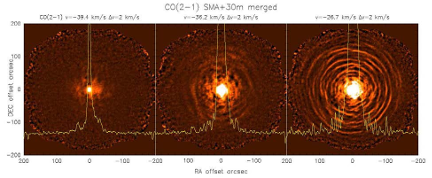
Larger View
Fig. 1: Three velocity-channel maps of the CO (2-1) emission in IRC+10216, observed with the SMA and the IRAM 30-m telescope at a resolution of 3"x4" (HPBW). The V = −39 km/s velocity-channel (left) is at the terminal velocity and represents the gas along the line of sight to the star, or close to the foreground polar cap, and the V = −26 km/s velocity-channel (right) represents the gas located in or near the plane of the sky. The yellow curves show the CO line intensity along a cut at the declination of the star (dec = 0). The bright rings visible on the right figure correspond to density-enhanced shells resulting from high-mass-loss episodes. Those are spaced by ≃ 800 yr. The left and middle images illustrate that the shells are clumpy. Note the increase of the noise at the outer edges of the mosiac.
View: Poster and Poster Blast
Mark Gurwell (CfA), Bryan Butler, and Arielle Moullet
A Serendipitous Line Survey of Titan in the 1.3 mm Band
The millimeter and submillimeter bands are rich in rotational transitions from many molecular species detected and/or expected in the atmosphere of Titan. The lines are typically well separated, and their line shapes, governed by both pressure broadening in the low- to mid-stratosphere and thermal broadening at higher altitudes, can be used to determine vertical abundance profiles given sufficient spectral resolution. The Submillimeter Array has been in operation for over 10 years and during that time has observed Titan several times as a science target. In addition, Titan is utilized at the SMA as a primary standard for flux calibration in the 1.3 mm, 1.1 mm, and 870µ transmission windows, although each calibration scan is typically only 10-20 minutes in length. Nonetheless, there have been many such observations during the SMA's operation, representing a sizable investment of telescope time and an opportunity for use in a serendipitous line survey. This poster will describe an initial archival project to locate, calibrate, and combine data from multiple SMA observations of Titan in the 1.3mm band. A total of 218 different data sets were identified, calibrated, and resampled into a broadband spectrum with over 110 hours of on-source integration time. We will present, to our knowledge, the first reported detection on Titan of DCN, and first detections in the millimeter bands of CH3C2H, vibrationally excited HC3N (v7 = 1 and v7 = 2), vibrationally excited CH3CN (v8 = 1).
View: Poster
Mark Gurwell (CfA)
The SMA Calibrator Flux Density History Database
Interferometric arrays such as the Submillimeter Array typically use short observations of strong point sources such as blazars, flat-spectrum radio-loud quasars, and BL Lac objects as calibration targets for correcting short-timescale atmospheric phase fluctuations and tracking instrumental phase drifts. Targets sufficiently bright to use as calibrators for current submillimeter facilities are relatively scarce, particularly at frequencies higher than 300 GHz. We present results from our long-term monitoring program of SMA calibration sources at 1.3 mm, 1.1 mm, and 870µ. Over the past 12 years, this program has amassed more than 22,200 individual flux-density measurements obtained through calibration of dedicated "flux" tracks, baseline determination tracks, and select science tracks. Rapid calibration of this data provides an up-to-date listing of currently bright sources, useful for planning SMA observations. In addition, our data set provides a rich and unique source of information on the mm/submm variability of more than 400 sources. Interest in the SMA as an observational resource has been particularly strong since the launch of the Fermi Gamma-ray Space Telescope, with data from the SMA Flux Density Database used in at least 45 peer-reviewed publications since 2008.
Complete presentation: Oral Session VI
Naomi Hirano (ASIAA), Chin-Fei Lee, and Hsien Shang
Spatio-Kinematic Structure at the Base of the Protostellar Jet
from L1448C(N)
The molecular jet driven by the class 0 protostar L1448C(N) was observed in the SiO J = 8-7 and CO J = 3-2 lines and 350 GHz continuum at ~ 0.6" (150 AU) resolution with the SMA. The subarcsecond images of SiO and CO successfully resolved the jet in its minor axis. The width of the jet increases gradually in the downstream direction with an opening angle of ~10 degrees. The intrinsic width of the jet is ~ 7080 AU at distances of 100-250 AU from the driving source, and becomes ~ 320 AU at a distance of 2500 AU. The L1448C(N) jet at its base has a similar width to the micro jets from Class II sources, while it is obviously wider than the HH211 jet having an intrinsic width of < 40 AU (Lee et al. 2009).
The jet from L1448C(N) has two velocity components; a high-velocity component (HVC) at dV~±60 km/s and a broad low-velocity component ranging at dV ~ 10-60 km/s. The HVC is seen in the jet body, while the LVC is spatially confined within ~ 200 AU from the source. The spatial and kinematic structures of the molecular jet in L1448C(N) are quite similar to those of the optical jets in Classical T Tauri stars and the near-infrared jets in Class I protostars. The observed spatio-kinematic structures imply that the molecular jet from L1448C(N) is driven by the same mechanism as the ionized jets in the later evolutionary stages.
Complete presentation: Oral Session IV
Li-Yen Hsu (University of Hawaii)
Ultra Dusty Milky Way/LIRG Galaxies Behind Massive Lensing Clusters
Recent submillimeter interferometric observations with the SMA toward massive lensing clusters have shown that there exists a population of high-redshift ultra dusty galaxies with far-infrared luminosities similar to that of the Milky Way and luminous infrared galaxies (LIRGs) but that are undetected in current deep radio, optical, and near-infrared surveys. These remarkable results suggest that a substantial amount of star formation in even the faint submillimeter populations may be hidden from rest-frame optical surveys.
Did Not Attend
Shan Huang (ASIAA)
HIghMass - High HI Mass, HI Rich Galaxies at z ~ 0: Sample Definition, Optical and Ha Imaging, and Star-Formation Properties
We present the first results of the study of a set of exceptional HI sources identified in the 40% ALFALFA extragalactic HI survey catalog as being both HI massive (MHI > 1010 M⊙ ) and having high gas fractions for their stellar masses: the HIghMass galaxy sample. We analyze UV- and optical- broadband and Hα images to understand the nature of their relatively underluminous disks in optical and to test whether their high gas fractions can be tracked to higher dark matter halo spin parameters or late gas accretion. Estimates of their star-formation rates (SFRs) based on SED-fitting agree within uncertainties with the Hα luminosity inferred current massive SFRs. The HII region luminosity functions, parameterized as (dN/d log L) ∝ Lα, have standard slopes at the luminous end (α = -1). The global SFRs demonstrate that the HIghMass galaxies exhibit active ongoing star formation (SF) with moderate SF efficiency, but relative to normal spirals, a lower integrated SFR in the past. Because the SF activity in these systems is spread throughout their extended disks, they have overall lower SFR surface densities and lower surface brightness in the optical bands. Relative to normal disk galaxies, the majority of HIghMass galaxies have higher Hα equivalent widths and are bluer in their outer disks, implying an inside-out disk growth scenario. Downbending double exponential disks are more frequent than upbending disks among the gas-rich galaxies, suggesting that SF thresholds exist in the downbending disks, probably as a result of concentrated gas distribution.
Complete presentation: Oral session I
A. Meredith Hughes (Wesleyan University)
Gas and Dust in Debris Disks
The tenuous, dusty debris disks observed around main-sequence stars hint at the properties of young planetary systems. We present two sets of observations with the Submillimeter Array (and now ALMA) that resolve gas and dust in debris disks to provide insight into the physical processes that shape young planetary systems and set the timeline for giant planet formation. The first set of observations uses resolved dust morphology in a small sample of debris disks around Solar-type stars to investigate the diversity of planetary system architectures and distinguish planet-induced structure from interactions between the disk and the interstellar medium. The second set of observations investigates the properties of an unusual class of debris disks that surprisingly host substantial molecular gas disks, despite clearly evolved dust. These gas-rich debris disks, with ages up to 40 Myr, defy the standard assumption of simultaneous gas and dust evolution and provide insight into the timeline for giant planet formation.
Complete presentation: Oral Session VI-invited
Izaskun
Jiménez-Serra (ESO)
Chemistry and Star Formation: A Love-Hate Relationship
The development of the broad bandwidth receivers at the Submillimeter Array (SMA) a decade ago opened up the possibility to observe tens of molecular lines at high angular resolution simultaneously. The unprecedented wealth of molecular line data provided by the SMA allowed for the first time detailed studies of the chemistry in star-forming regions. These studies have revealed that chemistry is a useful tool to pin down the internal physical structure and the physical processes involved in the process of low-mass and high-mass star formation. In this talk, I will review the most important advances in our understanding of the star-formation process through chemistry thanks to the SMA, and I will present the challenges that will be faced in the next decade in this field of research thanks to the advent of new instrumentation such as the Atacama Large Millimeter/Submillimeter Array and the Square Kilometer Array.
View: Poster
Michael D. Johnson (CfA)
Polarimetry with the Event Horizon Telescope
The Event Horizon Telescope (EHT) is an effort to develop millimeter and submillimeter VLBI to image nearby black holes at resolutions comparable to their event horizons. Past work with the EHT has measured compact emission on such scales for Sgr A* and M87 and has also measured sub-parsec structure in more distant quasars. Polarimetry with the EHT enables a powerful extension of this work, mapping magnetic field structures via the highly polarized synchrotron emission. Polarization is also an excellent probe of rapid variability, especially for Sgr A*, and can convey rich astrometric information even with incomplete imaging. We report on results from our 2013 campaign, which demonstrate a sharp increase in the linear polarization fraction and variability with increasing baseline, and we demonstrate that current EHT data can potentially achieve microarcsecond relative astrometry of flaring regions on timescales of minutes.
Complete presentation: Oral Session VI-invited
Katharine G. Johnston (MPIA)
The Structure and Star-Forming Fate of the Galactic Center Cloud G0.253+0.016
The massive infrared dark cloud G0.253+0.016 projected 45 pc from the Galactic center contains ~ 105 M⊙ of dense gas while being mostly devoid of observed star-formation tracers. To scrutinize the physical properties, dynamics, and structure of this cloud with reference to its star-forming potential, we have carried out a concerted SMA and IRAM 30 m study of this cloud in dust continuum, CO isotopologues, shock-tracing molecules, as well as H2CO to trace the gas temperature. In this talk, I will first discuss our characterization of the dust cores within G0.253+0.016 at ~ 1.3 mm and our finding from H2CO that the kinetic temperature of the gas is > 320 K on size-scales of ~ 0.15 pc. I will also show that position-velocity diagrams of our observed lines show broad linewidths and strong shock emission in the south of the cloud, indicating that G0.253+0.016 is colliding with another cloud at vLSR ~ 70 km/s, and that the column density PDF of G0.253+0.016 is log-normal with no discernible power-law tail, consistent with little star formation, and that its width can be explained in the framework of theory predicting the density structure of clouds created by supersonic, magnetized turbulence. In addition, I will show that the delta-variance spectrum of this region is consistent with that expected for clouds with no star formation. Using G0.253+0.016 as a test-bed of the conditions required for star formation in a different physical environment to that of nearby clouds, our results show that there is not one column density threshold for star formation, but instead this value is dependent on the local physical conditions.
View: Poster
Svetlana Jorstad (Boston University)
Analysis of the Millimeter-Wave Variability of TeV Quasars
I will present time series analysis of the gamma-ray, optical, and 1.3 mm light curves of the three flat spectrum radio quasars (FSRQs) 1222+216, 1510-089, and 3C279. A combined study of the multifrequency light curves and parsec-scale jet kinematics of the quasars at 7 mm suggests that the gamma-ray emission region during outbursts is close to the mm-wave core of the jets. This is supported by detection of the quasars at TeV energies, since the VHE emission from FSRQs is expected to be absorbed internally if emitted within the broad line region.
This research is supported in part by NASA through Fermi Guest Investigator grants NNX11AQ03G and NNX13AO99G.
Complete presentation: Oral Session V-invited
Tomasz Kaminski (MPIfR)
Investigating Dust Formation and Mass Loss in Evolved Stars with the Submillimeter Array
Over the last decade, the Submillimeter Array has addressed the most pressing questions about phenomena related to mass loss from evolved stars. In addition to numerous regular observations of individual objects in selected spectral ranges, the SMA was used to obtain imaging and line surveys toward the most prototypical objects of this type (VY CMa, IRC+10216, and IK Tau) providing observational material of unprecedented scale and detail. Those observations revealed vast chemical complexity of both carbon- and oxygen-rich circumstellar envelopes and their complex spatio-kinematical characteristics. The most important discoveries made within these surveys will be presented along with new intriguing questions they suggest. A particular emphasis will be on SMA observations that greatly enhanced our understanding of dust production and processing by stars. Moreover, efforts to investigate the presence and role of magnetic fields in these objects in terms of unique spectropolarimetric studies with the SMA will be briefly mentioned.
View: Poster
Robert Kimberk (SAO), J. Test, P. Leiker, A. Faris
A 4- to 12-GHz Analog Autocorrelating Spectrometer to Measure Spectral Density of System Temperature
An analog autocorrelator is being developed to measure the frequency dependence of system temperature and derive data weighting for the Submillimeter Array (SMA). The autocorrelator operates between 4 and 12 GHz, the SMA IF bandwidth, and has about 1 GHz of spectral resolution. It is an adding interferometer, uses Schottky diode power detectors, is not phase switched, and uses very low 1/f noise op-amps. The signal processing follows the pseudo-inverse technique developed by A.I. Harris. A simple calibration, implemented during ambient load observations, has been developed to remove measurement drift. The goal for the instrument is to be able to determine the spectral density of system temperature to 1 percent rms in 1 second of observation time. The results will be used to determine multiplicative weights to be applied to the observational data of the SMA. The signal-to-noise of the SMA observations will be improved by giving greater weight to data taken with smaller system temperatures.
Complete presentation: Oral Session VI
Lars Kristensen (CfA)
Hot Water with the SMA in Low-Mass Protostars
One of the big surprises from both Spitzer and Herschel-PACS was the detection of hot water (Eup ~ several thousand K) toward low-mass embedded and disk sources. Data obtained toward embedded sources directly reveal that emission originates in wind/jet shocks. The interpretation of hot water in disks, on the other hand, relies on modeling of the water emission. An origin in the inner (R < few AU), warm (T ~ 600 K) disk is favored, but a wind origin cannot be ruled out. Both interpretations have implications for how much water is delivered to the inner system and thereby how much water is available in the disk.
I will present new observations obtained at the SMA, shedding new light on where the hot water is in low-mass protostellar sources. Observations of the 10(2,9)-9(3,6) water line at 321 GHz with the SMA toward one of the brightest hot-water disks reveal that the origin most likely is in the protostellar wind and not the disk. I will discuss the implications for our current understanding of where the hot water is in protostellar systems and put these observations in the context of previous SMA observations of thermal and nonthermal water emission. These observations open up a new avenue for the SMA to study the hot water content of low-mass protostellar systems at a range of evolutionary stages. Furthermore, they are highly complementary to space-based observations by Spitzer and Herschel but with the added, and crucial, diagnostic capability offered in terms of spectral and angular resolution.
Complete presentation: Oral Session V
Hauyu Baobab Liu (ASIAA)
Large SMA Mosaic Discovery of Molecular Gas Streams Penetrating the 2-4 pc Scale Circumnuclear Disk in the Milky Way
We have carried out a large 157-pointing mosaic with the SMA at 345 GHz toward the Galactic center. From both the spectral line and the dust continuum images, we for the first time discovered several warm molecular gas arms/arcs connecting to the 2-4 pc scale circumnuclear disk (CND). This resolved the long-standing issues of whether the Galactic CND is a stationary structure. We proposed that the CND is the tidally trapped inner part of the secularly accreted molecular gas streams, toward the central supermassive black hole Sgr A*. Our results have implications for the formation and the evolution of the dust toroids surrounding active galactic nuclei.
Did Not Attend
Yu-Qing Lou (Tsinghua Center for Astrophysics)
Testing Theoretical (M)HD Models of Dynamic Star-Forming Cores in Molecular Clouds by Observational Constraints
In the past decade, we have made a systematic effort to develop general polytropic (magnetized) hydrodynamic self-similar quasi-spherical models under self-gravity for star formation in dense cores embedded in molecular clouds and in Bok globules. These models include special cases of conventional polytropic and isothermal gas dynamics. In particular, we have used available observational diagnostics to constrain model development including various features of numerous molecular line profiles, (sub‑)millimeter radio continuum emissions, dust extinction, and atomic hydrogen 21 cm absorption line simultaneously. In recent years, we started to incorporate observations of the Delingha 13.7 m telescope (HCO+, N2H+) and the Urumqi 25 m telescope (NH3) in China into model considerations. For example, in addition to reproducing molecular line profiles of blue peaks higher than red peaks, we could also fit line profiles of red peaks higher than blue peaks in cases of star-forming cloud cores L1517B and FeSt 1-457 based on the so-called envelope expansion with core collapse (EECC) models with shocks.
View: Poster and Poster Blast
Xing Lu (CfA)
Revealing Initial Conditions of High-Mass Star Formation in IRDCs with the SMA
Infrared dark clouds (IRDCs) are recognized as nurseries of high-mass star formation in the Galaxy given that they are massive, dense, and cold. High-angular-resolution millimeter and sub-millimeter observations are necessary to penetrate the dense gas and resolve the embedded protostars in these clouds, in order to study the earliest phase of high-mass star formation. With the SMA, we selected four dense molecular cores probably at quite different evolutionary phases, in the IRDC G28.53, and measured their dust emission and molecular spectral lines. The cores at very early phases exhibit few spectral lines, while those that are more evolved exhibit complex organic molecular lines as well as outflow signatures. Both types of cores are massive (a few tens of solar mass). Furthermore, we are currently conducting a minisurvey of five filamentary IRDCs with the SMA in order to learn the relation between filaments and high-mass star formation. In summary, the SMA is a powerful tool to resolve dense cores and study embedded star formation in IRDCs.
View: Poster and Poster Blast
Meredith MacGregor (CfA)
A New Millimeter Look at the HD 15115 Debris Disk
We have used the Submillimeter Array (SMA) to make 1.3 millimeter observations of the debris disk surrounding HD 15115, an F-type star located in the 12 Myr-old b Pictoris moving group. This nearly edge-on debris disk (the "Blue Needle") has been previously well resolved in optical scattered light and displays an extreme asymmetry. Unlike scattered light that reflects tiny grains that are blown out by stellar radiation and swept by the interstellar medium, the thermal emission from large grains that dominate at millimeter wavelengths closely traces the locations of the dust-producing parent planetesimals. The SMA observations reveal a circumstellar belt of dust emission. We characterize the millimeter emission using Markov Chain Monte Carlo methods to fit parametric models directly to the visibilities and place limits on departures from axisymmetry.
Complete presentation: Oral Session I
Rita Mann (National Research Council Canada)
The Potential to Form Planets in the Orion Nebula
The formation of planetary systems is intimately connected to the properties of the circumstellar disks in which they are born. Disk studies to date have focused on regions like Taurus and Ophiuchus for their proximity; however, stars rarely form in such isolated environments. Most stars form in massive star-forming regions, and there is even clear evidence that our Sun formed near an OB association like that found in Orion. Using the Submillimeter Array (SMA), we surveyed 67 protoplanetary disks ("proplyds") at 850µ m in the Orion Nebula to determine their masses. The SMA, as the world's only submillimeter interferometer until ALMA, was uniquely capable of detecting dust emission from the Orion proplyds, making these results the first successful measurements of disk masses in an OB association. These observations have revealed the range of influence of nearby massive stars on disk evolution and allowed us to answer the long-standing question about whether enough material remains in the Orion disks to potentially form Solar System analogs.
Complete presentation: Oral Session V-invited
Daniel Marrone (University of
Arizona)
The Millimeter and Submillimeter View of Sgr A*
The center of the Milky Way glows brightly at submillimeter wavelengths, and this region has been a primary target for the Submillimeter Array since it was a three-element array in 2001. The Galactic center provides examples of many of the unique astrophysics in galactic nuclei, including both intense star formation and suppressed star formation, stellar feedback, and black hole accretion. I will provide an overview of this region and the key contributions of the SMA to our understanding. Among several topics, I will note the mysterious aspects of the black hole Sgr A* that have been revealed by the SMA over the past several years.
View: Poster
Alan Marscher (Boston University)
Linking Blazar Light Curves at 1 mm to Higher Frequencies: Intraday Variations Parsecs from the Black Hole
Common astronomical folklore places optical to gamma-ray emission in blazars close to the black hole and radio emission much farther out. While the latter is generally true at cm wavelengths, it is often untrue at mm wavelengths. A particularly noteworthy event was the November 2010 mega-outburst in the quasar 3C 454.3. The 1 mm flux measured by the SMA exhibited a sharp flare that was essentially simultaneous with an equally sharp optical and gamma-ray flare. Optical depth arguments place the event parsecs from the black hole. Such extremely rapid, intraday variability on parsec scales needs a new paradigm. Two contenders are the author's new model involving turbulent plasma crossing shocks and another invoking sudden particle acceleration in localized magnetic reconnections.
This research is supported in part by NASA through Fermi Guest Investigator grants NNX11AQ03G, NNX12AO79G, and NNX13AP06G.
Complete presentation: Oral Session VI-invited
Anaëlle Maury (CEA/IRFU/AIM)
Unveiling the Physics of Star Formation with the SMA: A Decade's Retrospective
Ten years ago, the development of the Submillimeter Array (SMA) opened the window of sub-arcsecond angular-resolution observations at submillimeter wavelengths. Since the youngest low-mass and high-mass protostellar objects have the peak of their SEDs close to these wavelengths, the SMA allowed the star-formation community to carry out detailed studies of the very early stages of star formation, with unprecedented angular resolution and sensitivity.
I will show how millimeter and submillimeter interferometric observations of the youngest protostars allowed significant progress in our understanding of the accretion and ejection processes in both the low-mass and high-mass regimes of the protostellar mass distribution.
Significant results obtained to characterize the angular momentum content and multiplicity fraction of the youngest star-forming cores, as well as observational work that contributed to constrain the early stages of disk formation, will be presented.
Finally, I will propose a list of key questions about the physics of star formation that remain open and should be addressed in the next decade, with the SMA and also new large interferometric facilities such as ALMA and NOEMA.
Complete presentation: Oral Session VIII-invited
Karl M. Menten (MPIfR)
The Next Decade
In the 1980s, when the SMA was proposed to the Smithsonian Institution, the submillimeter sky was large unexplored. The JCMT and the CSO were still in the buildup or planning phases, while some of the first mm-wavelength interferometry with the Berkeley Hat Creek Interferometer provided tantalizing first glimpses into the arcsecond-resolution regime of star-forming regions.
While visionary in many of its technical sections, the SMA proposal (the "Yellow Book") could not foresee the richness of science that the SMA and other submillimeter telescopes would reveal. For example, the only molecule discussed extensively is CO, and some of the objects for which the SMA has made its most visible contributions weren't even known, namely, protoplanetary disks and high-redshift star-forming galaxies. Much of the SMA's success builds on its instrumental developments, which are constantly evolving. Given the above, it seems difficult to predict the main directions the SMA will take from here, although it is clear that many of its established science areas will remain fertile for the foreseeable future. I shall outline a number of opportunities, including the strong synergies that have emerged between the SMA and ALMA.
View: Poster
James Moran (CfA), Mark Gurwell, and Dan Marrone
Waiting for G2
We have been monitoring the flux density of Sgr A* with the SMA since June 1, 2013, in order to document any unusual changes associated with the breakup of the orbiting body known as G2, which reached perihelion in early 2014. Flux density enhancement is expected at centimeter wavelengths due to shock-induced emission as G2 crosses the plane of the putative accretion disk, or in proportion to the average flux density across the radio spectrum due to the change in accretion rate with respect to the approximate ambient level of about 10-8 M⊙/yr caused by the infalling debris of G2. We have made snapshot measurements of about 15 minutes' duration as often as possible, to a limit of once per day, using the SMA in whatever configuration and frequency are available. To date, we have measurements on 88 distinct days, roughly uniformly spaced, but with a major gap between November 2013 and March 2014 when Sgr A* was relatively close in angle to the sun. At frequencies between 218 and 355 GHz (1.3 and 0.8 mm wavelength), the flux density was always in the range of 2.0 to 6.0 Jy. This range is consistent with the historical range of variability of Sgr A*. Our data are intended to serve as an alarm to trigger more intensive observations should a substantial change in flux density outside the normal range occur. Our data set is rather irregular in cadence of observations and frequency coverage; it is sub-Nyquist sampled, since Sgr A* has been known to vary on the time scale of hours at the frequencies observed. Nonetheless, the database is an important information source. For example, we have estimated the average turnover frequency of Sgr A* and we have determined the power spectrum of the fluctuations over periods of 1 day to a few months.
Complete presentation: Oral Session V-invited
Arielle Moullet (NRAO)
From Venus to Pluto: The SMA at the Forefront of Thermal Mapping in the Solar System
Observations at (sub)millimeter wavelengths of Solar System bodies are an important component of planetary studies and are highly complementary of observations from planetary missions. The analysis of (sub)millimeter emission, corresponding to the thermal emission from surfaces and/or from atmospheric rotational lines, allows one to retrieve unique physical and chemical properties that are essential to fully characterize the individual bodies. These include, among others, vertical thermal profiles and winds in upper (or thin) atmospheres, abundance of minor atmospheric species (CO, HCN, HDO, SO2, ...), surfaces' radiative and thermal properties. Such information is also necessary to identify processes acting on atmospheres and surfaces as well as to derive clues pertaining to the formation and evolution of the Solar System.
Thanks to its unprecedented spatial resolution at submillimeter wavelengths, the Submillimeter Array has pioneered high spatial-resolution thermal observations on several bodies of the Solar System, allowing us to reach a new level of understanding of the spatial distribution of atmospheric and surface properties. In this talk, I will present scientific results based on the most significant Solar System observations performed with the SMA on planets (Venus, Jupiter, Neptune), moons (Io, Titan), and dwarf planets (Pluto/Charon system) and how they paved the way for observations with ALMA.
Complete presentation: Oral Session IV
Desika Narayanan (Haverford College)
High-Redshift Galaxy Formation in the Era of the SMA
Submillimeter-selected galaxies (SMGs) at high-redshift (z = 2-6) are the most luminous, heavily star-forming galaxies in the Universe. While they have been the subject of incredible numbers of observational and theoretical studies, their physical nature still eludes us. Are they typically gas-rich mergers, as the most luminous galaxies in the local Universe? Or heavily star-forming disks? What are their stellar masses? Redshift distributions? Is a top-heavy IMF necessary to reconcile cosmological simulations with the observed number counts?
The SMA has made fundamental advances in our understanding of these enigmatic objects by way of constraining their source multiplicity, and redshift distribution. In my presentation, I will describe complementary state-of-the-art cosmological simulations coupled with dust and molecular line radiative transfer aimed at understanding the origin, physical nature of, and evolutionary density of SMGs. I will show how the SMA's contributions in this field provided critical clues for our theoretical models and have led to a converged observational and theoretical picture for the physical form of this galaxy population. I will end with an outlook for important observational directions modern-day submm wave facilities can take to provide substantial contributions in this field.
Complete presentation: Oral Session I-invited
Karin Öberg (CfA)
The Chemistry of Protoplanetary Disks
The gas and dust in circumstellar disks around young stars are the reservoirs from which planets form. Characterizing the composition of this material is thus key to predict the bulk composition of nascent planets as well as the likelihood that such planets become seeded with volatiles and organics. The composition of the cold disk gas, which carries most of the disk mass, can only be probed by emission lines of trace species such as CO, HCN, and H2CO at (sub-)millimeter wavelengths. Such emission lines are also often the best and sometimes the only tools to constrain other disk characteristics such as temperature, density, and kinematic profiles. I will review the advances that have been made in this exciting area during the past decade, focusing on the power of spatially resolved observations of molecular emission lines. Highlights are the discovery of radial gradients in molecular abundances, including disk snowlines, an active deuterium chemistry, and a richer chemistry in disks surrounding T Tauri stars compared to the more massive Herbig Ae stars.
Complete presentation: Oral Session VI
Aina Palau (CRyA-UNAM)
A Class 0 Proto-Brown Dwarf Candidate Driving a Compact Molecular Outflow
I will present Submillimeter Array observations of the 870µ continuum and CO (3-2) line emission of the faint object IC348-SMM2E near the driving source of the HH797 outflow in the IC348 cluster. The continuum emission shows an unresolved source for which we estimate a mass of gas and dust of 30 MJupiter, and the CO line reveals a compact bipolar outflow, which is also seen in CO (2-1), with its center of symmetry in IC348-SMM2E. We also present new Caltech Submillimeter Observatory continuum data at 350µ. In order to constrain the accreted mass of the object, we additionally gathered data from the Spitzer and Herschel observatories as well as previous submillimeter observations and computed the Spectral Energy Distribution (SED). The SED can be fitted with one single modified blackbody function from 70µ to 2.1 cm with a dust temperature of ~ 23 K, a dust emissivity index of 0.7, and an envelope mass of 45 MJupiter. The bolometric luminosity is 0.09 L⊙, and the bolometric temperature is 34 K. Thus, IC348-SMM2E is comparable to the known Class 0 objects in the stellar domain. An estimate of the final mass (current plus accreted in the future) indicates that IC348-SMM2E will most likely remain substellar, and a comparison of the outflow parameters with those of low-mass young stellar objects shows that the IC348-SMM2E outflow force matches the trend with luminosity known for stellar objects. Thus, IC348-SMM2E constitutes an excellent example of a Class 0 proto-brown dwarf candidate that forms as a scaled-down version of a low-mass star.
View: Poster
Nimesh Patel (CfA), C. Gottlieb, K. Young
Probing the Dust-Formation Zone in IRC+10216 with the SMA
Submillimeter imaging of high-excitation molecular rotational lines is a powerful probe of the dust formation and acceleration region (R≤ 5 x 1016cm) in the extreme carbon-rich star IRC+10216. We present SMA observations of several rotational lines of SiCC from our 345 and 400 GHz spectral-line surveys, showing a progression from rectangular to narrow triangular line-profiles, and spatially extended to pointlike unresolved emission, as a function of increasing excitation energy. Maps of SiC and SiN emission show asymmetrical extended shell-like structures. These results are compared with published chemical model calculations of the radial abundances of molecules believed to be relevant for dust formation.
View: Poster
Nimesh Patel (CfA), S. Leiker, R. Christensen, J. Cheng, H. Nishioka
Upgrade of Optical Pointing Guidescopes for the SMA
The SMA antennas require recalibration of pointing models to correct for mount errors, following each move of antennas during array reconfiguration. An optical telescope with a CCD camera mounted behind a hole in one of the panels of the primary dish is used to observe bright stars for pointing calibration. We are in the process of upgrading this optical pointing system with the Santa Barbara Instrumentation Group's ST-i camera. At present, three of the antennas have this new system installed, and all antennas will be upgraded by the end of 2014. Measurements with the new system show that we can achieve about 2" rms residual errors in the derived pointing models despite a very coarse plate scale of 15.2" per pixel, with the 100 mm focal length lens. The new system has the advantages of compactness and hence stiffness in mounting, and very high sensitivity, which allows offset pointing measurements on random fields during normal radio observations.
View: Poster
Alison Peck (NRAO), Melanie Krips, Sergio Martin, Kazushi Sakamoto
SMA Observations of NGC253 at 690 GHz
We present preliminary results of the first interferometric observations of the 12CO (J=6-5) emission in NGC 253 using the Submillimeter Array. We compare the 12CO (J=6-5) emission with preexisting data on 12CO (J=3-2), 12CO (J=2-1) and 12CO (J=1-0) in NGC 253 at similar angular resolutions. The 12CO (J=6-5) emission is clearly detected along the disk of NGC 253, however no emission is detected close to the superbubbles that have been seen toward the edges of the disk in the lower-J CO transitions.
View: Poster
Glen Petipas (CfA)
Advances in Observing and Operational Strategies over the Last Decade
In this poster, I present a time line showing major changes to SMA operations over the last 10 years. I will highlight the innovations in software and hardware that became available to scientists and staff. Additionally, I will present some of the main time- and cost-saving strategies we have adopted over the years, which hopefully go completely unnoticed by even the most experienced SMA user.
Not Available
Chunhua Qi (CfA), David Wilner, Karin Öberg, Yuri Aikawa
Distribution of DCO+/HCO+ in the Disk of TW Hya: Revisited
Deuterated molecules are important tracers of the thermal history of gas in protoplanetary disks. The extent of deuterium enrichment, specifically the DCO+/HCO+ ratio as a function of radius, depends sensitively on the temperature structure and CO freeze-out in the disk. Understanding deuterium fractionation in the disk gas offers insights into a variety of topics, including the delivery of volatiles to the early Earth by comets.
We have previously explored the radial distribution of the DCO+/HCO+ ratio in the TW Hya disk and found that the ratio increases by more than 10 times from radii < 30 to > 70 AU, indicating that in situ deuterium fractionation is ongoing in the disk, which must be considered in the investigation of the origin of primitive solar system bodies (Qi et al. 2008). However, this study was limited by the fact that (1) the ratio was obtained using emission from the HCO+ 3-2 line, which is optically thick in the disk, and (2) the effect of vertical temperature gradient on the DCO+/HCO+ ratio was not considered in the previous model. Here we present the new SMA observations of H13CO+ 3-2 emission toward TW Hya to investigate the radial variation of the DCO+/HCO+ ratio in the disk of TW Hya. We also discuss how the distribution of DCO+/HCO+ is affected by both the radial and vertical temperature profiles in the disk.
Complete presentation: Oral Session VI
Keping Qiu (Nanjing University)
SMA Observations of Magnetic Fields in High-Mass Protoclusters: A Tale of Two Cores
Massive stars tend to form in clusters, which arise from the collapse and fragmentation of dense molecular cloud clumps and cores. The role of magnetic fields in this process has been the subject of great debates for decades. We have carried out polarimetric observations of two massive cluster-forming cores, G35.2-0.74N and G240.31+0.07, using the SMA in its subcompact, compact, and extended configurations. The two cores, both with masses of order 100 M⊙ and filamentary morphologies, are fragmenting along their major axes to form protoclusters. Thanks to the high sensitivity and angular resolution of the observations, we were able to readily resolve the morphologies of the magnetic fields. We detected a clear hourglass aligned with outflow and rotation axes in one core and an "L-shaped" magnetic field in the other. By jointly analyzing the observed magnetic field and kinematic properties, and also considering the orientations of large-scale magnetic fields revealed by single-dish observations, we find that magnetic fields appear to play a dominant role in the formation of the massive cluster-forming cores, whereas in their further dynamical evolution, spun-up rotation can set in to drastically alter the field structures.
References
Qiu et al. 2013, ApJ, 779, 182
Qiu et al. 2014, submitted
Complete presentation: Oral Session VI
Ramprasad Rao (ASIAA)
Detection of a Magnetized Disk around a Very Young Protostar
We present subarcsecond resolution polarimetric observations of the 878 μm thermal dust continuum emission obtained with the Submillimeter Array toward the IRAS 16293-2422 protostellar binary system. We report the detection of linearly polarized dust emission arising from the circumstellar disk associated with the IRAS 16293-2422 B protostar. The fractional polarization of ≃1.4% is only slightly lower than that expected from theoretical calculations in such disks. The magnetic field structure on the plane of the sky derived from the dust polarization suggests a complex magnetic field geometry in the disk, possibly associated with a rotating disk that is wrapping the field lines as expected from the simulations. The polarization around IRAS 16293-2422 A at subarcsecond angular resolution is only marginally detected.
Complete presentation: Oral Session II-invited
Kazushi Sakamoto (ASIAA)
SMA Discoveries in Nearby Galaxies
Only about 10% of SMA publications have been about nearby galaxies. Still, they have reported a number of discoveries and breakthroughs made possible with the first interferometer for submillimeter-wave imaging at the superb Mauna Kea site in Hawaii. I will review the highlights from about 50 SMA papers published on nearby galaxy observations. They include analyses of high-excitation molecular lines from warmer ISM regions than previously probed with millimeter-wave interferometers, dust imaging of the very cores of infrared luminous galaxies, and discoveries in southern-sky galaxies that other radio arrays in the Northern Hemisphere could not reach. These SMA discoveries are being actively followed up with ALMA and other telescopes.
View: Poster
Benjamin Sargent (RIT)
SMA Observations of Mass Loss from OH/IR Stars in the Galactic Bulge
Mass-losing asymptotic giant branch (AGB) stars are expected to be a major source of gas and dust in galaxies. These intermediate mass (0.8-8 M⊙) stars lose mass because dust grains form around them, experience radiation pressure from the star that drives them away, and shepherd the surrounding gas along with them in a stellar outflow. OH/IR stars, so-named because of their detected infrared and OH maser emission, are AGB stars experiencing high mass-loss rates. They therefore contribute significantly to mass returned to a galaxy, so it is important to measure their mass-loss rates. However, it is difficult to measure the gas mass-loss rate, which is essentially the total mass-loss rate, for stars outside of the Milky Way Galaxy because the emission from CO, a reliable tracer of the gas mass loss-rate, is typically too faint for extragalactic sources. On the other hand, many OH/IR stars within our Galaxy suffer from distance ambiguity, which affects the mass-loss rate that would be determined from their CO observation. We therefore use the SMA to observe OH/IR stars in the inner Galactic bulge. Bulge stars have a known distance, about 8 kpc, which reduces the distance ambiguity and allows more direct constraints of their mass-loss rates. By combining gas mass-loss rates, determined from CO measurements, with dust mass-loss rates, determined by modeling the optical-to-infrared spectral energy distributions (SEDs; plots of flux vs. wavelength) of these stars, we may compute gas-to-dust ratios. By learning how gas-to-dust ratio varies, we may determine gas mass-loss rates for AGB stars in other galaxies, for which we can only relatively easily determine dust mass-loss rates from observations of the dust continuum emission at infrared wavelengths, and compute more reliable galactic mass budgets. We discuss past, present, and planned SMA observations of the Bulge to determine the mass-loss rates and gas-to-dust ratios of OH/IR stars in the Bulge and their implications. We also discuss future plans for submillimeter- and millimeter-wavelength observations of OH/IR stars.
View: Poster
Rudolph Schild (CfA)
The Expected Polarization of Inner-Region Emissions of Sgr A* from the Steven Hawking Meta-Stable Quantum State Model
Steven Hawking has recently described a black hole variant with an "apparent horizon" in place of an infinite density event horizon. He has described it as a "meta-stable quantum state." This was pursued 10 years ago by Leiter and Robertson, who derived a quantum electrodynamical equation of state, closing the set of equations. Their solutions are given as tables of (finite) surface density, redshift, temperature, and luminosity.
Because of electron-positron pair production, the object transmits a surface magnetic field. The authors have also considered the case of Bondi accretion and mapped the predicted magnetic field patterns, luminous structures, and polarizations. Because the surface radiates with a known temperature, its redshift-corrected (distantly observed) spectrum peaks in the submillimeter.
View: Poster and Poster Blast
TK Sridharan (CfA), M. Saito, N.A. Patel
Holographic Validation Measurements of the SMA Antennas
High-frequency operation of the Submillimeter Array calls for a surface accuracy of 12µ for the antennas. High signal-to-noise, high-spatial-resolution near-field holography at 232.4 GHz employing a low-power beacon is used to measure and correct panel deviations including flexures. Low-spatial-resolution celestial holographic measurements are used to study gravitational deformation. We describe the methods and summarize our experience.
View: Poster and Poster Blast
TK Sridharan (CfA), R. Rao, K.
Qiu, P. Cortes, H. Li, T. Pillai,
N.A. Patel, Q. Zhang
Hot Core, Outflows, and Magnetic Fields in W43-MM1
(G30.79 FIR 10)
We present submillimeter spectral line and dust continuum polarization observations of a remarkable hot core and multiple outflows in the high-mass, star-forming region W43-MM1 (G30.79 FIR 10), obtained using the Submillimeter Array. A temperature of ~ 400 K is estimated for the hot core using CH3CN =(J = 19-18) lines, with detections of 11 K-ladder components. The high temperature and the mass estimates for the outflows indicate high-mass star formation. The continuum polarization pattern shows an ordered distribution, and its orientation over the main outflow appears to be aligned with the outflow. The derived magnetic field indicates slightly supercritical conditions. While the magnetic and outflow energies are comparable, the B-field orientation appears to have changed from parsec scales to ~ 0.1 pc scales during the core/star formation process.
View: Poster and Poster Blast
TK Sridharan (CfA), C.E. Tong, J. Test, R. Christensen, R. Rao,
S. Leiker
A Vector Near-Field Scanner for Inter-Band Illumination and Beam Co‑Alignment
Co-alignment of pointing and aperture illumination centering between different SMA receiver bands is important for simultaneous operation in multiple bands and essential for polarimetry. We describe a vector near-field scanner to achieve this goal in the field, where receiver upgrades often result in alignment degradation. The scanner maps the complex E-field over an image of the aperture that occurs in the beam wave-guide optics, using SMA receivers and reference tones already available in the system. These measurements are used to derive adjustments to the optics required to obtain illumination and pointing alignment.
View: Poster and Poster Blast
Ai-Lei Sun (Princeton University)
ALMA Observations of a Candidate Molecular Outflow in Obscured Quasar SDSS J1356+1026
We present ALMA CO (1-0) and CO (3-2) observations of an obscured quasar and ULIRG SDSS J1356+1026. This system is a merging system hosting a 20-kpc scale ionized outflow. The CO observations show disturbed molecular gas in a compact nuclear disk and a 5 kpc tidal arm. We find redshifted high velocity (v ~ 500 km/s) component at the nucleus, as a potential sign of molecular outflow. Such an outflow could deplete the nuclear disk within a million years with a high outflow rate of 350 M⊙/yr. Since the star formation is inadequate as the energy source, this outflow is most likely AGN driven, making it one of the most compact and low momentum cases known.
View: Poster and Poster Blast
Shigehisa Takakuwa (ASIAA)
Direct SMA Imaging of the Transition from the
Infalling Envelopes to the Keplerian Disks around the Protostellar Binaries
L1551 IRS 5
and NE
We report our recent SMA studies of protostellar binary sources L1551 IRS 5 and NE in CS (7-6) and C18O (3-2) at subarcsecond resolution. In both L1551 IRS 5 and NE, the high-velocity (> 1.0 km/s) molecular emission is well reproduced with geometrically thin Keplerian disk models surrounding the protostellar binaries, Keplerian circumbinary disk. The low-velocity components show signatures of infalling gas motions of the envelopes surrounding the central Keplerian disks. The infalling velocities are slower than the free-fall velocities toward the central protostellar masses of ~ 0.5 M⊙ in L1551 IRS 5 and ~ 0.8 M⊙ in NE derived from the Keplerian rotations in the central disks, suggesting deceleration of the infalling speeds. The infalling envelope around L1551 IRS 5 exhibits vrot ~ r-1 rotation, i.e., rotation with the conserved angular momentum, and the rotational profile smoothly connects to the central Keplerian disk. On the other hand, the infalling envelope around L1551 NE does not show any detectable rotation, suggesting discontinuity of the rotational angular momenta from the infalling envelope to the Keplerian disk. In this talk, I will discuss these SMA results in the context of the physics of disk formation in protostellar envelopes.
View: Poster
John Test (CFA) and the SWARM Development Team
Antenna IF Simulator System for the Development of the New Digital Back End
The development of FPGA bit code for the new digital back end (SWARM) is a complex, iterative process. The ability to test and debug newly compiled correlator designs requires a laboratory system that can emulate the analog back end of the SMA array. We have developed an antenna IF simulator system that provides four channels of independently phase-programmable correlated wideband noise. The block outputs provide an IF for the ADCs that reside in the SWARM ROACH2 assemblies. The phases of the four correlated noise outputs are synchronously loaded every 10 ms on the rising edge of a heartbeat signal. Each block output is programmed with its own set of phase values that correspond to a Walsh pattern for a single baseline. In addition to Walshing, the programmable phase registers can be used to simulate phase rotation on any of the correlated noise outputs. The antenna IF simulator system has eased the transition of the SWARM hardware from laboratory to summit.
View: Poster
C. Edward Tong (CfA), Raymond
Blundell, Chih-Chiang Han,
Tse-Jun Chen, Wei-Chun Lu, and Ming-Jye Wang
Wideband Receiver Upgrade for the Submillimeter Array
A new generation of SIS receivers offering wider IF bandwidth has emerged in recent years. For radio astronomical applications, the wider bandwidth improves the total power (or continuum) sensitivity of the instrument. Furthermore, it increases the flexibility for spectral line observations. The Submillimeter Array (SMA), a radio interferometer of eight 6-m telescopes on Mauna Kea, HI, has embarked on a wideband system upgrade, replacing its original SIS receivers with wideband receivers, which double the instantaneous bandwidth.
The new SMA receivers are based on distributed superconducting tunnel junction arrays, comprising three or four SIS junctions connected in series. The use of a series junction array reduces the impact of the geometrical capacitance of the SIS junctions and increases the linearity range of the receiver, both of which are important for wide IF design. The SIS mixer chips were fabricated in the SIS fabrication facility of ASIAA in Taipei.
In addition to the new distributed SIS mixer, we have also upgraded the entire IF system at the SMA. Wideband 200 and 300 GHz receivers have been installed in all eight antennas of the array, and they are being used for routine astronomical observations. Currently, the SMA offers a 4-6 GHz IF in addition to an additional 2 GHz wide IF band, which can be located anywhere between 6 and 14 GHz. A new dedicated digital back end is being developed, and once complete, the SMA will offer a total IF bandwidth of 16 GHz: 8 GHz for each sideband.
We will report on the design and performance of the upgraded SMA receivers in this presentation.
Poster: Not Available
Jean Turner (UCLA)
Hot Gas from Cold Accretion: The Molecular "Supercloud" in the Dwarf Galaxy NGC 5253
Our SMA map of CO (3-2) emission in the dwarf galaxy NGC 5253 reveals a hot GMC coincident with the well-studied supernebula. The CO (3-2) gas is bright, appears to be optically thin, and hot (T > 300 K). In spite of the presence of ~ 7000 O stars within the young super star cluster, the linewidth of its GMC is only 9 km/s. The star-formation efficiency is at a record high. We detect CO (3-2) with more normal characteristics from the streamer of gas that is falling into the galaxy. The 870μm continuum emission is whopping bright. The inferred gas-to-dust ratio is extremely low, significantly lower than Galactic values, which is unexpected for a low metallicity (sub-LMC) galaxy. We suspect that many of the unusual properties of this galaxy and its super star formation are due to its unusual disposition of molecular gas.
View: Poster and Poster Blast
Tim A. van Kempen (Leiden Observatory)
The First Galactic Detection of the 183 GHz Water Maser: The Case of Serpens SMM1
While hunting for thermal water emission from the ground, the unique receivers of the SMA provided the very first interferometric detection of a 183 GHz water maser in our Milky Way. It was surprisingly found around a low-mass protostar: Serpens SMM1. As the 183 GHz (313-220 transition) water maser possesses one of the lowest transition energies (~ 200 K) of all the water masers, the low temperature and density regimes found in low-mass star formation can generate the required population inversion. Three maser spots were located along the red outflow, almost a 1,000 AU away from the protostar, much farther away than previous maser emission in Serpens SMM 1. The spots were seen to be slightly infalling, but close to the source velocity. This unique detection proved to be a major clue for the role of water during star formation. Since then, Herschel-HIFI indeed revealed that water emission is very strongly tied to outflow physics within or near the cavity wall. In this talk, I will revisit our discovery and show the connection between thermal and maser emission. I will conclude with the potential for future 183 GHz studies in star formation, which remains a unique capability of the SMA.
Poster: Not Available
Sven Van Loo (CfA), Eric Keto, and Qizhou Zhang
Core and Filament Formation in Magnetized, Self-Gravitating Isothermal Layers
Molecular clouds exhibit a hierarchical density structure with stars forming in their densest regions. Often, these star-forming complexes have an elongated, filamentary shape. Recent Herschel observations of such filaments show a column density profile that deviates from hydrostatic equilibrium. Several explanations have been proposed but have not elucidated the formation process. We will discuss the formation of filaments in self-gravitating layers by gravitational instabilities. Self-gravitating layers are unstable to perturbations and fragment into clumps or thin filaments. When the layers are threaded by magnetic fields, fragmentation is still possible. Numerical simulations of the gravitational instability in magnetized layers produce density structures similar to observed ones. The filament network that forms is either a hub-filament or a parallel-filament network, depending on the magnitude of the magnetic field. Although the filaments are collapsing, the central region of the filament can be perfectly described by an equilibrium density distribution. Excess mass accumulates at radii larger than the scale height, resulting in a density and column density distribution that is flatter than for an equilibrium cylinder. We do not reproduce the quasi-constant filament width because no additional support is provided even though we include magnetic fields. Finally, using SMA polarization observations, we will interpret the filamentary network of the massive star-forming complex G14.225-0.506 in terms of the gravitational instability model.
Complete presentation: Oral Session IV-invited
Wei-Hao Wang (ASIAA)
Submillimeter Array Studies of High-Redshift Galaxies
Galaxies in the universe underwent rapid buildup of their stellar mass since z ~ 6, reaching a maximum comoving star-formation rate density at z ~ 2-1. In this period, a large portion of galactic star formation was obscured by dust, making rest-frame UV a biased tracer of the cosmic star formation. In the past decade, the Submillimeter Array has made remarkable contributions to the understanding of the dust-hidden side of the high-redshift galaxy evolution. The SMA found the first evidence of the existence of a high-redshift (z > 4) tail of the submillimeter galaxy population. With observations of galaxies strongly lensed by foreground galaxies and galaxy clusters, the SMA has reached the normal star-forming galaxy population, providing crucial knowledge about high-redshift normal galaxies, as well as the internal structure of the galaxy lenses and the underlying cosmology. The SMA made the first detection of high-redshift [CII] emission, and recently it also successfully carried out a blind [CII] redshift search. In this talk, I will summarize the achievement of the SMA in the above fields, including results from SAO, UH, ASIAA, and external SMA users.
Complete presentation: Oral Session II
Linda Watson (CfA)
The Resolved Vertical Structure of Molecular Gas in Edge-On Disk Galaxies
Edge-on, bulgeless disk galaxies show a sharp transition in the optical/near-infrared appearance of their dust lanes at a circular velocity (vcirc) of 120 km/s (stellar mass ~ 1010 M⊙). Galaxies with vcirc > 120 km/s (high-mass galaxies) have well-defined dust lanes while galaxies with vcirc < 120 km/s (low-mass galaxies) have diffuse dust lanes or no obvious dust lanes. Radiative transfer models suggest that this transition is due to a change in the dust scale height, such that high-mass galaxies have small dust scale heights relative to their stellar scale heights (zdust ~ 0.5 zstars) and low-mass galaxies have dust scale heights approximately equal to their stellar scale heights (zdust ~ zstars). However, these results are model dependent, and the transition in the appearance of dust lanes could also be explained by a transition in the dust-to-gas ratio. We used the Submillimeter Array to spatially resolve the vertical distribution of CO (2-1) in two high-mass, edge-on galaxies. I will describe our direct measurements of the scale height of the cold interstellar medium in these galaxies. I will also compare our results to predictions from radiative transfer models, under the assumption that the molecular gas and dust have similar scale heights.
Complete presentation: Oral Session VII-invited
Ann E. Wehrle (Space Science Institute)
Using Time-Domain Astronomy to Explore AGN and Other
Energetic Objects
Time variability in AGN and other energetic objects tells us about the physical processes involved. Panoramic and all-sky telescopes that detect flaring or fading can trigger alerts for other observatories. In AGN, physical changes in the accretion disk, corona, and relativistic jets are revealed by the amplitude and power distribution of photometric variations, by delays in response of emission lines to changes in the ionizing continuum radiation, by delays in flares detected at various wavebands, and by imaging of moving Doppler-boosted features in the jets. Machine learning techniques in data-mining enable the conductors of surveys to pinpoint events unusual enough to warrant rapid follow-up by other observatories for multiwavelength investigations. While truly extraordinary events will galvanize many observers to take action within 24 hours, long-term follow-up observations require flexible time allocation processes and careful prioritization. I will discuss recent and current time-domain surveys, how various strategies for using that data have worked for intensive investigations of AGN physics, and development of new strategies for future surveys generating very large data streams.
View: Poster
Jonathan Weintroub (CfA) and the SWARM Development
Team
SWARM: A Compact High-Resolution Correlator and Wideband VLBI Phased-Array Upgrade for SMA
A new digital back end is being commissioned on Mauna Kea. The SMA Wideband Astronomical ROACH2 Machine, or SWARM, processes a 4 GHz usable band in single polarization mode and is flexibly reconfigurable for 2 GHz full Stokes dual polarization. The hardware is based on the open source Reconfigurable Open Architecture Computing Hardware 2 (ROACH2) platform from the Collaboration for Astronomy Signal Processing and Electronics Research (CASPER). A 5 GSps quad-core analog-to-digital converter board uses a commercial chip from e2v installed on a CASPER-standard printed circuit board designed by Homin Jiang's group at ASIAA. Two ADC channels are provided per ROACH2, each sampling a 2.3 GHz Nyquist band generated by a custom wideband block downconverter. The ROACH2 logic includes 16k-channel Polyphase Filterbank (F-engine) per input followed by a 10 GbE switch based corner-turn, which feeds into correlator-accumulator logic (X-engines) colocated with the F-engines. This arrangement makes very effective use of a small amount of digital hardware (just eight ROACH2s in 1U rack mount enclosures). The primary challenge now is to meet timing at full speed for a large and very complex FPGA bit code. Design of the VLBI phased sum and recorder interface logic is also in process.
Our poster will describe the instrument design, with the focus on the particular challenges of ultra wideband signal processing. Early connected commissioning and science verification data will be presented.
View: Poster
David Wilner (CfA)
"Birth Rings" of Planetesimals in Nearby Debris Disks
Debris disks around young main-sequence stars result from the collisional grinding of planetesimals, relics of planet formation analogous to comets and asteroids. The millimeter emission from debris disks is dominated by large grains that uniquely trace the unseen population of dust-producing planetesimals. We review our SMA programs that provided the first well-resolved images of millimeter emission from the debris disks surrounding the nearby ~ 20 Myr-old stars β Pic and AU Mic. For these systems, each of which is viewed nearly edge-on, the SMA reveals a belt of millimeter emission surrounding the star with the same geometry as the more extended disk imaged in optical scattered light. Simple modeling shows that the locations of these millimeter emission belts are consistent with reservoirs of planetesimals ("birth rings") invoked to explain the detailed shape of the midplane scattered light surface brightness profiles. For both systems, the SMA programs have been followed up by ALMA studies that reveal more detail in the millimeter emission structure.
View: Poster and Poster Blast
Hsi-Wei Yen (ASIAA)
Unveiling the Evolutionary Sequence from Infalling Envelopes toward Formation of Keplerian Disks around Low-Mass Protostars
We have been conducting SMA observations of protostellar sources in the C18O (2-1) line and 1.3 mm continuum emission. Our primary goal is to unveil evolutionary processes from infalling protostellar envelopes to formation of Keplerian disks around protostars. We found that on 100-1000 AU scales around the Class 0 protostars B335 and NGC 1333 IRAS 4B, the protostellar envelopes show infalling motions but no detectable rotational motion. Around the Class 0 and 0/I protostars L1448-mm and L1527 IRS, the protostellar envelopes exhibit rotational motions with the rotational velocities proportional to r-1 on 100-1000 AU scales, i.e., rotation with a conserved angular momentum. Around the more evolved sources, the Class I protostars TMC-1A and L1489 IRS, the surrounding gas on hundreds of AU scales shows faster rotation with the rotational velocities proportional to r-0.5, i.e., Keplerian rotation. Our SMA results demonstrate an evolutionary trend of the gas motions toward the formation of Keplerian disks. In this talk, I will review our group's results with the SMA and present our future plans to study disk formation with it.
Complete presentation: Oral Session IV
Min Yun (UMass)
SMA [C II] Study of High Redshift Galaxies
Study of high-redshift galaxies using 157µ [C II] line as a tracer of star-formation activity and cold gas content has been one of the key science motivations for the Smithsonian's Submillimeter Array (SMA). While early studies of high-z galaxies were challenged by the sensitivity, the discovery of strongly lensed submillimeter galaxies (SMGs) by large area surveys has produced a large sample of potential targets where the combination of the angular resolution of SMA and the lensing model can yield valuable new insight into spatially resolved information on cold gas and star-formation activities in these distant galaxies. The recent improved sensitivity in the 350 GHz band also brings a broader range of unlensed SMGs within the scope of SMA study, including our recent [C II] observations of the z = 4.3 COSMOS AzTEC1 source, which was also extensively studied in continuum by Younger et al. previously. I will describe these new observations in detail and the prospect of future SMA [C II] studies of other similar systems identified by AzTEC imaging and CO spectroscopy using the Large Millimeter Telescope.
Complete presentation: Oral Session VI
Luis Zapata (CRyA-UNAM)
Explosive Outflows Revealed by the Submillimeter Array
In this talk, I will present the results of recent observations using the SMA and ALMA of the massive star-forming region Orion BN-KL. The SMA observations revealed that the well-known enigmatic wide-angle outflow located in this star-forming region was produced by such a violent explosion during the disruption of a massive young stellar system about 500 years ago, suggesting that this flow belongs to a totally different family of molecular flows. I will demonstrate that the "hot core" located at the heart of Orion BN-KL is probably heated externally by this peculiar event. Finally, I will show evidence for another possible case (DR21) where an explosive outflow is present.
Complete presentation: Oral Session VII
Bevin A. Zauderer (CfA), G. Petitpas, E. Berger, R. Margutti, G.G. Pooley, R. Sari, A.M. Soderberg, A. Brunthaler, and M.F. Bietenholz
The Unexpected Discovery of a Relativistic Jet from the Tidal Disruption Event Swift J1644+57
The tidal disruption of a star by a supermassive black hole (SMBH) has long been predicted to produce optical/UV/soft X-ray transient emission from a newly formed accretion disk, but in the past three years, it was discovered that some fraction of tidal disruption of stars by SMBHs can launch relativistic jets, beginning with the gamma-ray source Swift J1644+57 discovered on 25 March 2011. We will discuss the observational evidence leading to the conclusion that Swift J1644+57 is a tidal disruption event, including the crucial role of early SMA observations. We will then present a summary of over three years of our team's multiwavelength radio observational campaign in conjunction with Swift/XRT and Chandra X-ray observations, highlighting the unique opportunity tidal disruption events afford to study the birth and cessation of a relativistic jet, to probe the environment around previously dormant SMBHs, and to discover lower-mass SMBHs. We will conclude with a future outlook for this unique Swift event and observational strategies for similar tidal disruption events discovered in the coming years, potentially in large numbers in the era of large optical surveys like LSST.
View: Poster
Qizhou Zhang (CfA)
How to Make Massive Cores: Lessons Learned with the SMA
Massive protostars are born in parsec-scale molecular clumps that collapse and fragment, leading to the formation of a cluster of stellar objects. How massive molecular clumps fragment to give rise to a cluster of stellar objects has been a puzzle for decades. The physical condition (temperature and density) in molecular clumps limits the Jeans mass to about 1 M⊙. While this characteristic mass corresponds well with the peak of the initial stellar mass function, it is problematic for massive star formation since dense cores much larger than 1 M⊙ tend to further fragment into lower-mass entities. In this poster, I will present studies from the SMA. I will present high-resolution observations of massive molecular clumps at very early evolutionary stages, and discuss fragmentation of molecular clumps and the implication of these findings to current theoretical ideas of massive star and cluster formation.
View: Poster
Jun-Hui Zhao (CfA), Chat Hull, Mel Wright, and Goran Sandell
Magnetic Field, CO Molecular Gas, and Dust in the Region Surrounding NGC 7538 IRS1
Based on CARMA polarization and spectral-line observations along with the analysis of SMA, JCMT and VLA archival data, we imaged the dust continuum emission along with the CO molecular lines from the region surrounding NGC 7538 IRS1, an ultra-compact HII region in a star-formation complex. We will present our findings on the magnetized medium surrounding the IRS 1 core in which vigorous star-formation activities take place. We will discuss the possible origins of the magnetic field as well as the effects on the accretion flow due to the feedback produced from the newly formed early spectral type O star associated with IRS1.



